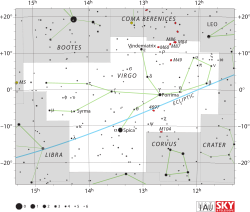Rho Virginis
| Rho Virginis (ρ) | |
 | |
| Observationsdata Epok: J2000.0 | |
|---|---|
| Stjärnbild | Jungfrun |
| Rektascension | 12t 41m 53,05658s[1] |
| Deklination | +10° 14′ 51,1699″[1] |
| Skenbar magnitud () | 4,88 med amplitud 0,02 (V)[2] |
| Stjärntyp | |
| Spektraltyp | A0Va_1B[3] |
| U–B | 0,03[4] |
| B–V | 0,076 ± 0,001[5] |
| Variabeltyp | Pulserande variabel av Delta Scuti-typ (DSCTC)[2] |
| Astrometri | |
| Radialhastighet () | 1,6 ± 2[6] km/s |
| Egenrörelse (µ) | RA: 82,67 ± 0,20[1] mas/år Dek.: -89,08 ± 0,13[1] mas/år |
| Parallax () | 27,57 ± 0,21[1] |
| Avstånd | 118,3 ± 0,9 lå (36,3 ± 0,3 pc) |
| Absolut magnitud () | +1,90 ± 0,28[7] |
| Detaljer | |
| Massa | 2,0[8] M☉ |
| Radie | 1,6[8] R☉ |
| Luminositet | 14[8] L☉ |
| Temperatur | 8 930[8] K |
| Metallicitet | -1,00[9] |
| Vinkelhastighet | 154[10] km/s |
| Andra beteckningar | |
| 30 Virginis, GCRV 7626, JP11 2271, TD1 16435, GEN# +1.00110411, 2MASS J12415305+1014082, TYC 878-1102-1, GSC 00878-01102, N30 2928, UBV 11383, AG+10 1563, HD 110411, PMC 90-93 921, UBV M 18508, AKARI-IRC-V1 J1241530+101407, HIC 61960, PPM 129256, uvby98 100110411 V, BD+11 2485, HIP 61960, ROT 1873, WISE J124153.12+101407.6, FAUST 3382, HR 4828, SAO 100211, YZ 10 4649, FK5 1326, IRAS 12394+1030, SKY# 23677, BFA97 160, GC 17276, IRAS F12393+1030, SRS 31326[3] | |
Rho Virginis (ρ Virginis, förkortat Rho Vir, ρ Vir), som är stjärnans Bayer-beteckning, är en ensam stjärna i den norra delen av stjärnbilden Jungfrun. Den har en genomsnittlig skenbar magnitud på +4,88[6] och är synlig för blotta ögat där ljusföroreningar ej förekommer. Baserat på parallaxmätningar i Hipparcos-uppdraget på 27,6[7] mas beräknas den befinna sig på ca 118 ljusårs (36 parsek) avstånd från solen.
Egenskaper
[redigera | redigera wikitext]Rho Virginis är en blå till vit stjärna i huvudserien av spektralklass A0 V.[11] Den har en massa som är ungefär dubbelt så stor[8] som solens massa, en radie som är ca 1,6[8] gånger större än solens och utsänder ca 14[8] gånger mera energi än solen från dess fotosfär vid en effektiv temperatur på ca 8 900 K.[8]
Rho Virginis, eller 30 Virginis, är en pulserande variabel av Delta Scuti-typ (DSCTC). Den har en skenbar magnitud av +4,88 och varierar med amplitud av 0,02 enheter över perioder på 0,5 till 2,4 timmar.[2]
Rho Virginis är registrerad som en Lambda Boötis-stjärna med lågt överskott av järn. Det har ett överskott av infraröd strålning, men det är oklart huruvida detta orsakas av en eventuell omgivande stoftskiva eller från stjärnan vid passage genom och uppvärmning av ett diffust interstellärt stoftmoln. Mest sannolikt är det förra,[8] i vilket fall stoftskivan har en radie på cirka 37 AE och en genomsnittlig temperatur på 90 K.[12]
Se även
[redigera | redigera wikitext]Referenser
[redigera | redigera wikitext]- Den här artikeln är helt eller delvis baserad på material från engelskspråkiga Wikipedia, Rho Virginis, 27 mars 2019.
Noter
[redigera | redigera wikitext]- ^ [a b c d e] van Leeuwen, F. (November 2007). "Validation of the new Hipparcos reduction". Astronomy and Astrophysics. 474 (2): 653–664. arXiv:0708.1752. Bibcode:2007A&A...474..653V. doi:10.1051/0004-6361:20078357.
- ^ [a b c] ”Rho Vir” (på engelska). The International Variable Star Index. AAVSO – American Association of Variable Star Observers. http://www.aavso.org/vsx/index.php?view=detail.top&oid=38125. Läst 10 augusti 2017.
- ^ [a b] ”Basic data: V* rho Vir – Variable Star of delta Scuti type” (på engelska). Centre de Données astronomiques de Strasbourg. http://simbad.u-strasbg.fr/simbad/sim-basic?Ident=Rho+Vir&submit=SIMBAD+search. Läst 10 augusti 2017.
- ^ Johnson, H. L.; et al. (1966), "UBVRIJKL photometry of the bright stars", Communications of the Lunar and Planetary Laboratory, 4 (99), Bibcode:1966CoLPL...4...99J.
- ^ van Leeuwen (2007). ”Hipparcos, the New Reduction” (på engelska). http://vizier.u-strasbg.fr/viz-bin/VizieR-5?-out.add=.&-source=I/311/hip2&HIP=61960. Läst 10 augusti 2017.
- ^ [a b] Wielen, R.; et al. (1999), Sixth Catalogue of Fundamental Stars (FK6). Part I. Basic fundamental stars with direct solutions (35), Astronomisches Rechen-Institut Heidelberg, Bibcode:1999VeARI..35....1W.
- ^ [a b] Paunzen, E.; et al. (November 2002), "The status of Galactic field λ Bootis stars in the post-Hipparcos era", Monthly Notices of the Royal Astronomical Society, 336 (3): 1030–1042, arXiv:astro-ph/0207488, Bibcode:2002MNRAS.336.1030P, doi:10.1046/j.1365-8711.2002.05865.x.
- ^ [a b c d e f g h i] Martínez-Galarza, J. R.; et al. (March 2009), "Infrared Emission by Dust Around λ Bootis Stars: Debris Disks or Thermally Emitting Nebulae?", The Astrophysical Journal, 694 (1): 165–173, arXiv:0812.2198, Bibcode:2009ApJ...694..165M, doi:10.1088/0004-637X/694/1/165.
- ^ Sturenburg, S. (September 1993), "Abundance Analysis of Lambda-Bootis Stars", Astronomy and Astrophysics, 277 (1): 139, Bibcode:1993A&A...277..139S.
- ^ Royer, F.; Zorec, J.; Gómez, A. E. (February 2007), "Rotational velocities of A-type stars. III. Velocity distributions", Astronomy and Astrophysics, 463 (2): 671–682, arXiv:astro-ph/0610785, Bibcode:2007A&A...463..671R, doi:10.1051/0004-6361:20065224.
- ^ Cowley, A.; et al. (April 1969), "A study of the bright A stars. I. A catalogue of spectral classifications", Astronomical Journal, 74: 375–406, Bibcode:1969AJ.....74..375C, doi:10.1086/110819.
- ^ Zuckerman, B.; Song, Inseok (March 2004), "Dusty Debris Disks as Signposts of Planets: Implications for Spitzer Space Telescope", The Astrophysical Journal, 603 (2): 738–743, arXiv:astro-ph/0311546, Bibcode:2004ApJ...603..738Z, doi:10.1086/381700.





